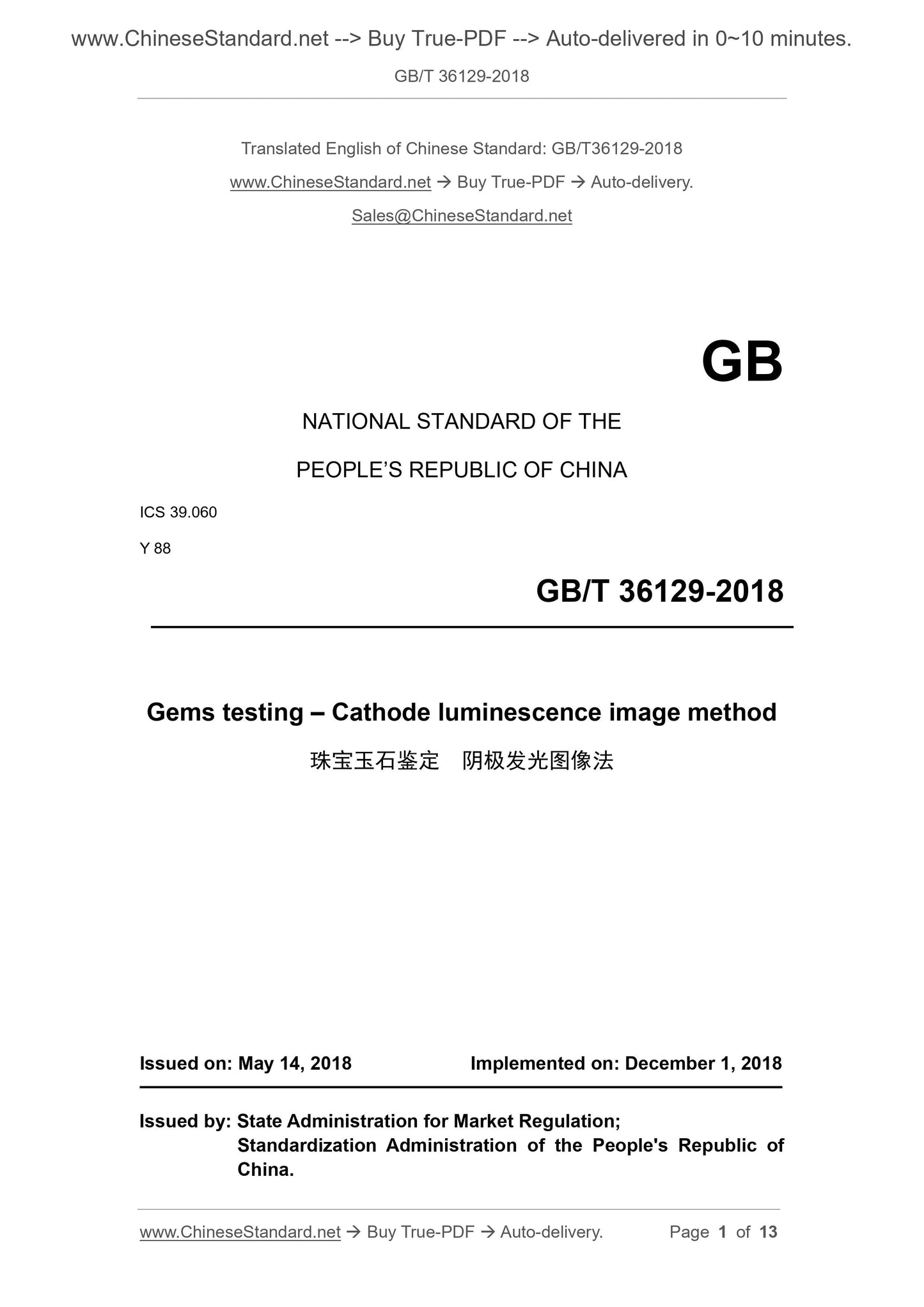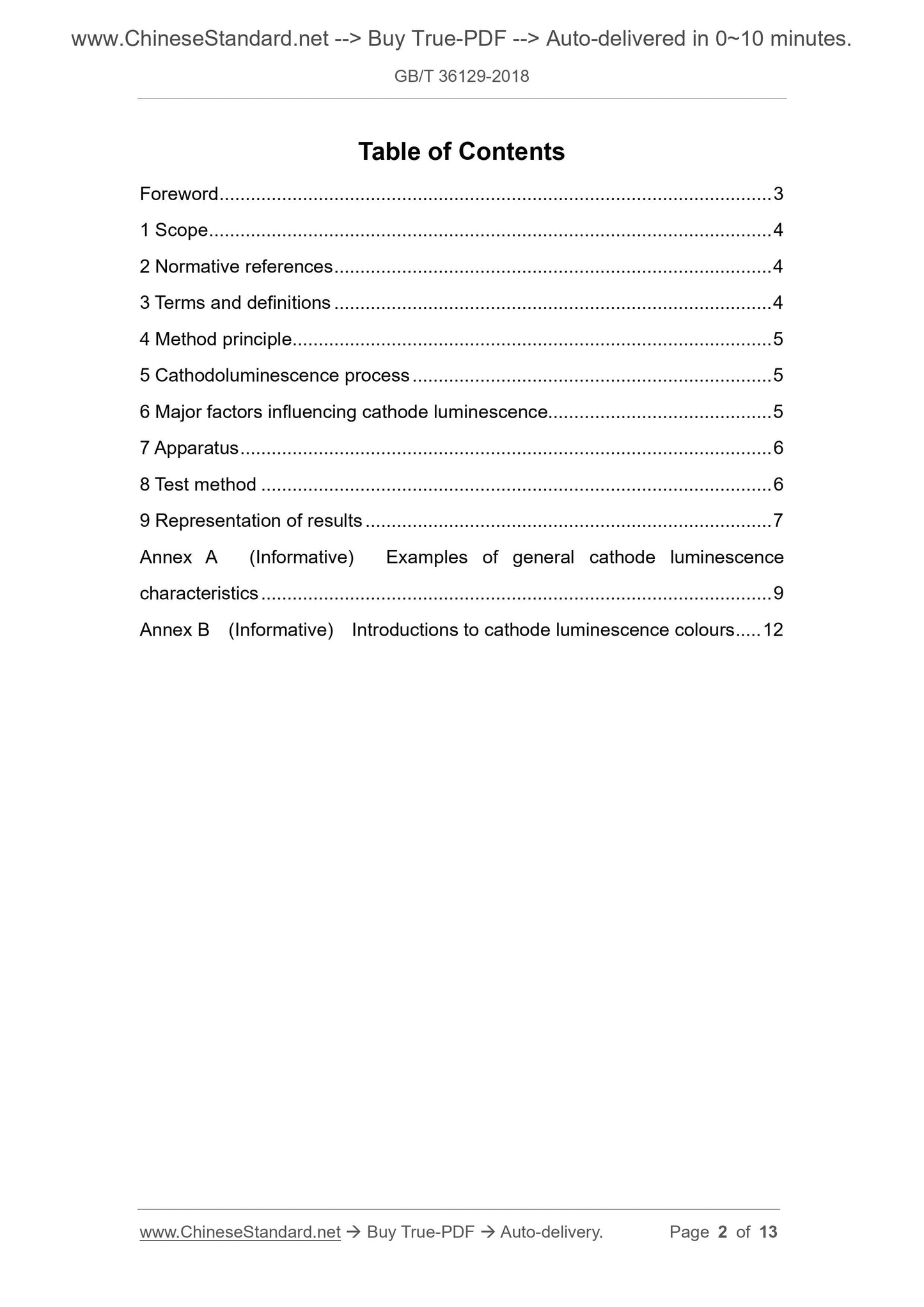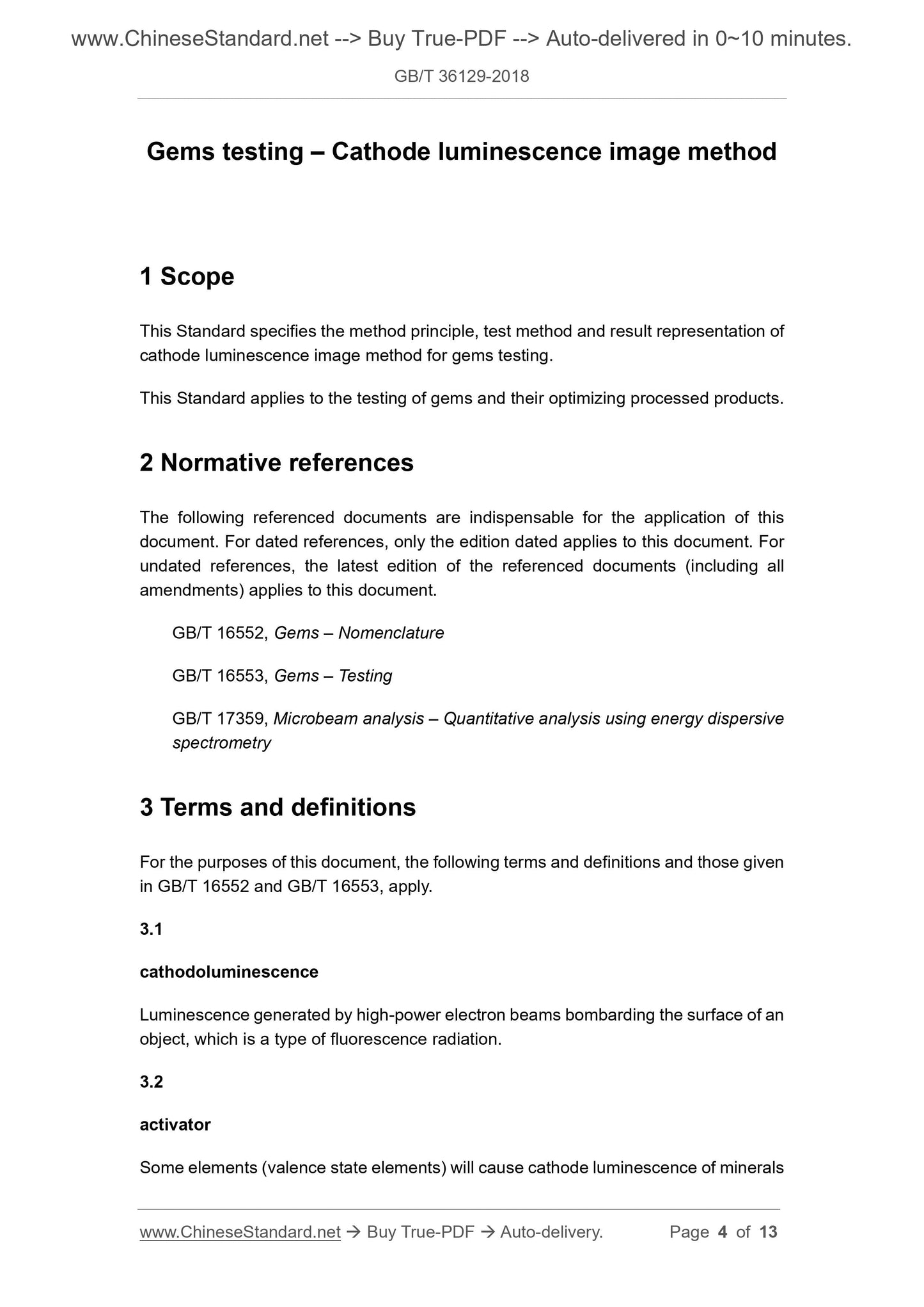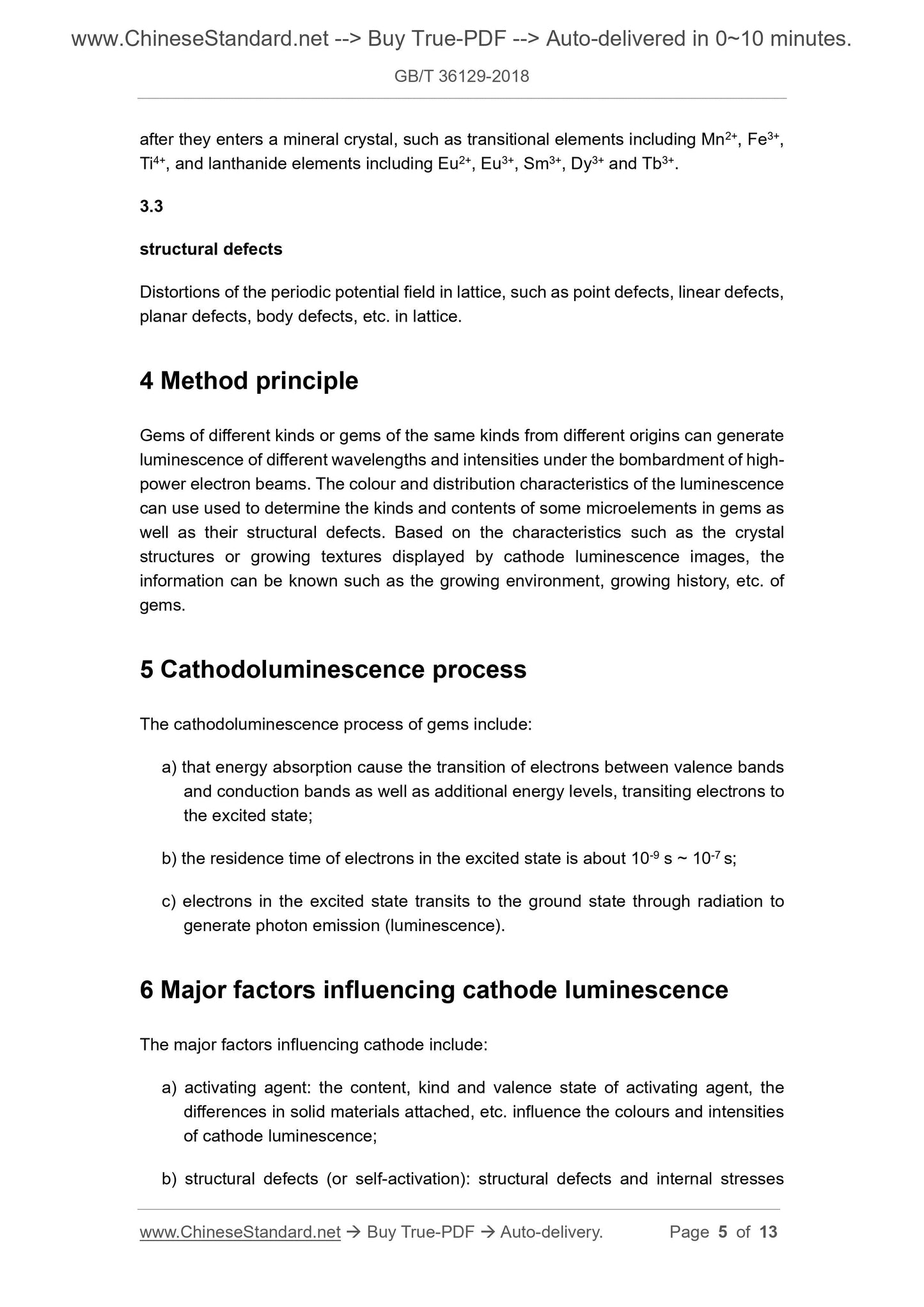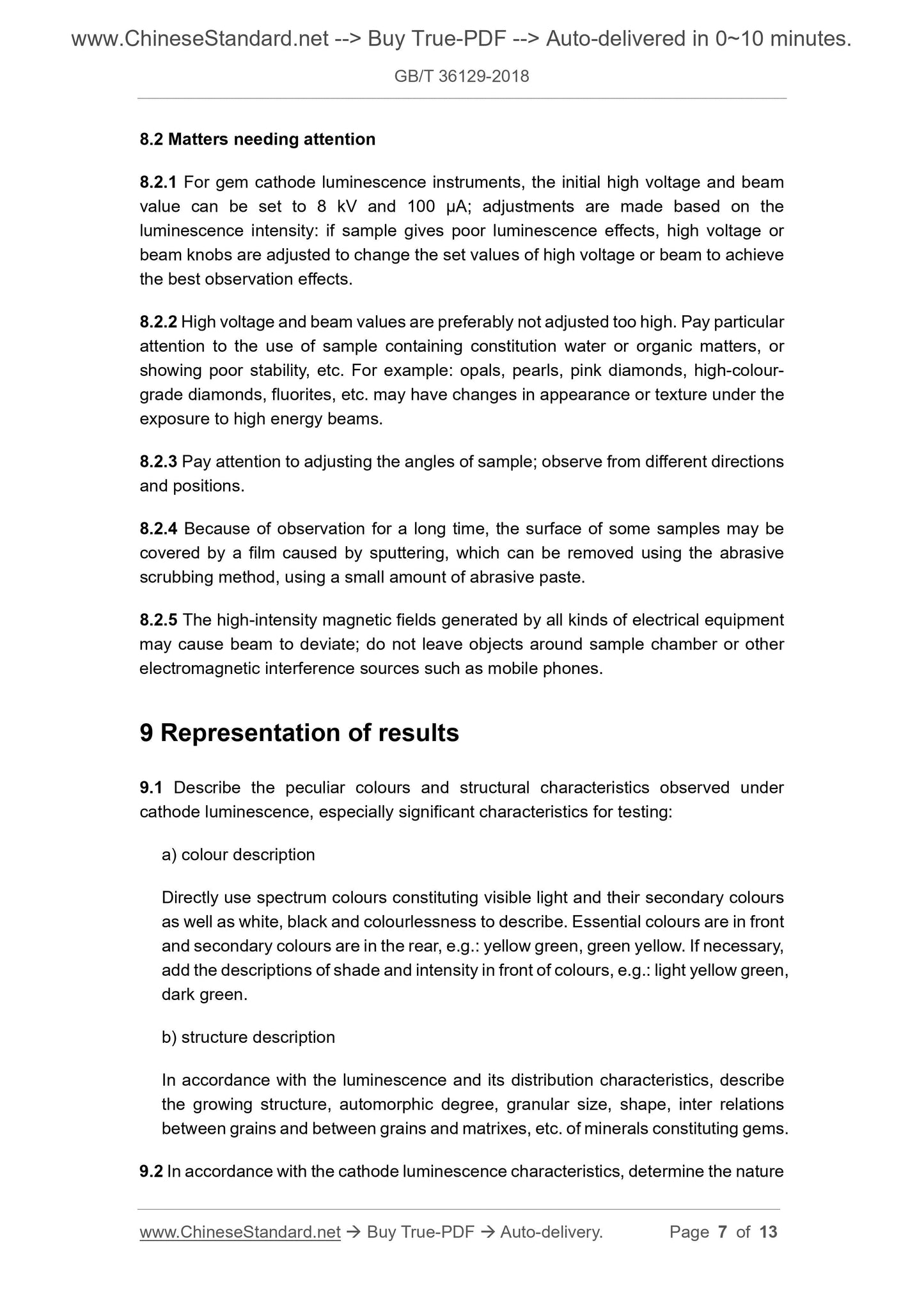1
/
of
5
www.ChineseStandard.us -- Field Test Asia Pte. Ltd.
GB/T 36129-2018 English PDF (GB/T36129-2018)
GB/T 36129-2018 English PDF (GB/T36129-2018)
Regular price
$140.00
Regular price
Sale price
$140.00
Unit price
/
per
Shipping calculated at checkout.
Couldn't load pickup availability
GB/T 36129-2018: Gems testing - Cathode luminescence image method
Delivery: 9 seconds. Download (& Email) true-PDF + Invoice.
Get Quotation: Click GB/T 36129-2018 (Self-service in 1-minute)
Historical versions (Master-website): GB/T 36129-2018
Preview True-PDF (Reload/Scroll-down if blank)
GB/T 36129-2018
GB
NATIONAL STANDARD OF THE
PEOPLE’S REPUBLIC OF CHINA
ICS 39.060
Y 88
Gems testing – Cathode luminescence image method
ISSUED ON. MAY 14, 2018
IMPLEMENTED ON. DECEMBER 1, 2018
Issued by. State Administration for Market Regulation;
Standardization Administration of the People's Republic of
China.
Table of Contents
Foreword ... 3
1 Scope ... 4
2 Normative references ... 4
3 Terms and definitions ... 4
4 Method principle ... 5
5 Cathodoluminescence process ... 5
6 Major factors influencing cathode luminescence... 5
7 Apparatus ... 6
8 Test method ... 6
9 Representation of results ... 7
Annex A (Informative) Examples of general cathode luminescence
characteristics ... 9
Annex B (Informative) Introductions to cathode luminescence colours ... 12
Gems testing – Cathode luminescence image method
1 Scope
This Standard specifies the method principle, test method and result representation of
cathode luminescence image method for gems testing.
This Standard applies to the testing of gems and their optimizing processed products.
2 Normative references
The following referenced documents are indispensable for the application of this
document. For dated references, only the edition dated applies to this document. For
undated references, the latest edition of the referenced documents (including all
amendments) applies to this document.
GB/T 16552, Gems – Nomenclature
GB/T 16553, Gems – Testing
GB/T 17359, Microbeam analysis – Quantitative analysis using energy dispersive
spectrometry
3 Terms and definitions
For the purposes of this document, the following terms and definitions and those given
in GB/T 16552 and GB/T 16553, apply.
3.1
cathodoluminescence
Luminescence generated by high-power electron beams bombarding the surface of an
object, which is a type of fluorescence radiation.
3.2
activator
Some elements (valence state elements) will cause cathode luminescence of minerals
after they enters a mineral crystal, such as transitional elements including Mn2+, Fe3+,
Ti4+, and lanthanide elements including Eu2+, Eu3+, Sm3+, Dy3+ and Tb3+.
3.3
structural defects
Distortions of the periodic potential field in lattice, such as point defects, linear defects,
planar defects, body defects, etc. in lattice.
4 Method principle
Gems of different kinds or gems of the same kinds from different origins can generate
luminescence of different wavelengths and intensities under the bombardment of high-
power electron beams. The colour and distribution characteristics of the luminescence
can use used to determine the kinds and contents of some microelements in gems as
well as their structural defects. Based on the characteristics such as the crystal
structures or growing textures displayed by cathode luminescence images, the
information can be known such as the growing environment, growing history, etc. of
gems.
5 Cathodoluminescence process
The cathodoluminescence process of gems include.
a) that energy absorption cause the transition of electrons between valence bands
and conduction bands as well as additional energy levels, transiting electrons to
the excited state;
b) the residence time of electrons in the excited state is about 10-9 s ~ 10-7 s;
c) electrons in the excited state transits to the ground state through radiation to
generate photon emission (luminescence).
6 Major factors influencing cathode luminescence
The major factors influencing cathode include.
a) activating agent. the content, kind and valence state of activating agent, the
differences in solid materials attached, etc. influence the colours and intensities
of cathode luminescence;
b) structural defects (or self-activation). structural defects and internal stresses
8.2 Matters needing attention
8.2.1 For gem cathode luminescence instruments, the initial high voltage and beam
value can be set to 8 kV and 100 μA; adjustments are made based on the
luminescence intensity. if sample gives poor luminescence effects, high voltage or
beam knobs are adjusted to change the set values of high voltage or beam to achieve
the best observation effects.
8.2.2 High voltage and beam values are preferably not adjusted too high. Pay particular
attention to the use of sample containing constitution water or organic matters, or
showing poor stability, etc. For example. opals, pearls, pink diamonds, high-colour-
grade diamonds, fluorites, etc. may have changes in appearance or texture under the
exposure to high energy beams.
8.2.3 Pay attention to adjusting the angles of sample; observe from different directions
and positions.
8.2.4 Because of observation for a long time, the surface of some samples may be
covered by a film caused by sputtering, which can be removed using the abrasive
scrubbing method, using a small amount of abrasive paste.
8.2.5 The high-intensity magnetic fields generated by all kinds of electrical equipment
may cause beam to deviate; do not leave objects around sample chamber or other
electromagnetic interference sources such as mobile phones.
9 Representation of results
9.1 Describe the peculiar colours and structural characteristics observed under
cathode luminescence, especially significant characteristics for testing.
a) colour description
Directly use spectrum colours constituting visible light and their secondary colours
as well as white, black and colourlessness to describe. Essential colours are in front
and secondary colours are in the rear, e.g.. yellow green, green yellow. If necessary,
add the descriptions of shade and intensity in front of colours, e.g.. light yellow green,
dark green.
b) structure description
In accordance with the luminescence and its distribution characteristics, describe
the growing structure, automorphic degree, granular size, shape, inter relations
between grains and between grains and matrixes, etc. of minerals constituting gems.
9.2 In accordance with the cathode luminescence characteristics, determine the nature
GB/T 36129-2018
GB
NATIONAL STANDARD OF THE
PEOPLE’S REPUBLIC OF CHINA
ICS 39.060
Y 88
Gems testing – Cathode luminescence image method
ISSUED ON. MAY 14, 2018
IMPLEMENTED ON. DECEMBER 1, 2018
Issued by. State Administration for Market Regulation;
Standardization Administration of the People's Republic of
China.
Table of Contents
Foreword ... 3
1 Scope ... 4
2 Normative references ... 4
3 Terms and definitions ... 4
4 Method principle ... 5
5 Cathodoluminescence process ... 5
6 Major factors influencing cathode luminescence... 5
7 Apparatus ... 6
8 Test method ... 6
9 Representation of results ... 7
Annex A (Informative) Examples of general cathode luminescence
characteristics ... 9
Annex B (Informative) Introductions to cathode luminescence colours ... 12
Gems testing – Cathode luminescence image method
1 Scope
This Standard specifies the method principle, test method and result representation of
cathode luminescence image method for gems testing.
This Standard applies to the testing of gems and their optimizing processed products.
2 Normative references
The following referenced documents are indispensable for the application of this
document. For dated references, only the edition dated applies to this document. For
undated references, the latest edition of the referenced documents (including all
amendments) applies to this document.
GB/T 16552, Gems – Nomenclature
GB/T 16553, Gems – Testing
GB/T 17359, Microbeam analysis – Quantitative analysis using energy dispersive
spectrometry
3 Terms and definitions
For the purposes of this document, the following terms and definitions and those given
in GB/T 16552 and GB/T 16553, apply.
3.1
cathodoluminescence
Luminescence generated by high-power electron beams bombarding the surface of an
object, which is a type of fluorescence radiation.
3.2
activator
Some elements (valence state elements) will cause cathode luminescence of minerals
after they enters a mineral crystal, such as transitional elements including Mn2+, Fe3+,
Ti4+, and lanthanide elements including Eu2+, Eu3+, Sm3+, Dy3+ and Tb3+.
3.3
structural defects
Distortions of the periodic potential field in lattice, such as point defects, linear defects,
planar defects, body defects, etc. in lattice.
4 Method principle
Gems of different kinds or gems of the same kinds from different origins can generate
luminescence of different wavelengths and intensities under the bombardment of high-
power electron beams. The colour and distribution characteristics of the luminescence
can use used to determine the kinds and contents of some microelements in gems as
well as their structural defects. Based on the characteristics such as the crystal
structures or growing textures displayed by cathode luminescence images, the
information can be known such as the growing environment, growing history, etc. of
gems.
5 Cathodoluminescence process
The cathodoluminescence process of gems include.
a) that energy absorption cause the transition of electrons between valence bands
and conduction bands as well as additional energy levels, transiting electrons to
the excited state;
b) the residence time of electrons in the excited state is about 10-9 s ~ 10-7 s;
c) electrons in the excited state transits to the ground state through radiation to
generate photon emission (luminescence).
6 Major factors influencing cathode luminescence
The major factors influencing cathode include.
a) activating agent. the content, kind and valence state of activating agent, the
differences in solid materials attached, etc. influence the colours and intensities
of cathode luminescence;
b) structural defects (or self-activation). structural defects and internal stresses
8.2 Matters needing attention
8.2.1 For gem cathode luminescence instruments, the initial high voltage and beam
value can be set to 8 kV and 100 μA; adjustments are made based on the
luminescence intensity. if sample gives poor luminescence effects, high voltage or
beam knobs are adjusted to change the set values of high voltage or beam to achieve
the best observation effects.
8.2.2 High voltage and beam values are preferably not adjusted too high. Pay particular
attention to the use of sample containing constitution water or organic matters, or
showing poor stability, etc. For example. opals, pearls, pink diamonds, high-colour-
grade diamonds, fluorites, etc. may have changes in appearance or texture under the
exposure to high energy beams.
8.2.3 Pay attention to adjusting the angles of sample; observe from different directions
and positions.
8.2.4 Because of observation for a long time, the surface of some samples may be
covered by a film caused by sputtering, which can be removed using the abrasive
scrubbing method, using a small amount of abrasive paste.
8.2.5 The high-intensity magnetic fields generated by all kinds of electrical equipment
may cause beam to deviate; do not leave objects around sample chamber or other
electromagnetic interference sources such as mobile phones.
9 Representation of results
9.1 Describe the peculiar colours and structural characteristics observed under
cathode luminescence, especially significant characteristics for testing.
a) colour description
Directly use spectrum colours constituting visible light and their secondary colours
as well as white, black and colourlessness to describe. Essential colours are in front
and secondary colours are in the rear, e.g.. yellow green, green yellow. If necessary,
add the descriptions of shade and intensity in front of colours, e.g.. light yellow green,
dark green.
b) structure description
In accordance with the luminescence and its distribution characteristics, describe
the growing structure, automorphic degree, granular size, shape, inter relations
between grains and between grains and matrixes, etc. of minerals constituting gems.
9.2 In accordance with the cathode luminescence characteristics, determine the nature
Delivery: 9 seconds. Download (& Email) true-PDF + Invoice.
Get Quotation: Click GB/T 36129-2018 (Self-service in 1-minute)
Historical versions (Master-website): GB/T 36129-2018
Preview True-PDF (Reload/Scroll-down if blank)
GB/T 36129-2018
GB
NATIONAL STANDARD OF THE
PEOPLE’S REPUBLIC OF CHINA
ICS 39.060
Y 88
Gems testing – Cathode luminescence image method
ISSUED ON. MAY 14, 2018
IMPLEMENTED ON. DECEMBER 1, 2018
Issued by. State Administration for Market Regulation;
Standardization Administration of the People's Republic of
China.
Table of Contents
Foreword ... 3
1 Scope ... 4
2 Normative references ... 4
3 Terms and definitions ... 4
4 Method principle ... 5
5 Cathodoluminescence process ... 5
6 Major factors influencing cathode luminescence... 5
7 Apparatus ... 6
8 Test method ... 6
9 Representation of results ... 7
Annex A (Informative) Examples of general cathode luminescence
characteristics ... 9
Annex B (Informative) Introductions to cathode luminescence colours ... 12
Gems testing – Cathode luminescence image method
1 Scope
This Standard specifies the method principle, test method and result representation of
cathode luminescence image method for gems testing.
This Standard applies to the testing of gems and their optimizing processed products.
2 Normative references
The following referenced documents are indispensable for the application of this
document. For dated references, only the edition dated applies to this document. For
undated references, the latest edition of the referenced documents (including all
amendments) applies to this document.
GB/T 16552, Gems – Nomenclature
GB/T 16553, Gems – Testing
GB/T 17359, Microbeam analysis – Quantitative analysis using energy dispersive
spectrometry
3 Terms and definitions
For the purposes of this document, the following terms and definitions and those given
in GB/T 16552 and GB/T 16553, apply.
3.1
cathodoluminescence
Luminescence generated by high-power electron beams bombarding the surface of an
object, which is a type of fluorescence radiation.
3.2
activator
Some elements (valence state elements) will cause cathode luminescence of minerals
after they enters a mineral crystal, such as transitional elements including Mn2+, Fe3+,
Ti4+, and lanthanide elements including Eu2+, Eu3+, Sm3+, Dy3+ and Tb3+.
3.3
structural defects
Distortions of the periodic potential field in lattice, such as point defects, linear defects,
planar defects, body defects, etc. in lattice.
4 Method principle
Gems of different kinds or gems of the same kinds from different origins can generate
luminescence of different wavelengths and intensities under the bombardment of high-
power electron beams. The colour and distribution characteristics of the luminescence
can use used to determine the kinds and contents of some microelements in gems as
well as their structural defects. Based on the characteristics such as the crystal
structures or growing textures displayed by cathode luminescence images, the
information can be known such as the growing environment, growing history, etc. of
gems.
5 Cathodoluminescence process
The cathodoluminescence process of gems include.
a) that energy absorption cause the transition of electrons between valence bands
and conduction bands as well as additional energy levels, transiting electrons to
the excited state;
b) the residence time of electrons in the excited state is about 10-9 s ~ 10-7 s;
c) electrons in the excited state transits to the ground state through radiation to
generate photon emission (luminescence).
6 Major factors influencing cathode luminescence
The major factors influencing cathode include.
a) activating agent. the content, kind and valence state of activating agent, the
differences in solid materials attached, etc. influence the colours and intensities
of cathode luminescence;
b) structural defects (or self-activation). structural defects and internal stresses
8.2 Matters needing attention
8.2.1 For gem cathode luminescence instruments, the initial high voltage and beam
value can be set to 8 kV and 100 μA; adjustments are made based on the
luminescence intensity. if sample gives poor luminescence effects, high voltage or
beam knobs are adjusted to change the set values of high voltage or beam to achieve
the best observation effects.
8.2.2 High voltage and beam values are preferably not adjusted too high. Pay particular
attention to the use of sample containing constitution water or organic matters, or
showing poor stability, etc. For example. opals, pearls, pink diamonds, high-colour-
grade diamonds, fluorites, etc. may have changes in appearance or texture under the
exposure to high energy beams.
8.2.3 Pay attention to adjusting the angles of sample; observe from different directions
and positions.
8.2.4 Because of observation for a long time, the surface of some samples may be
covered by a film caused by sputtering, which can be removed using the abrasive
scrubbing method, using a small amount of abrasive paste.
8.2.5 The high-intensity magnetic fields generated by all kinds of electrical equipment
may cause beam to deviate; do not leave objects around sample chamber or other
electromagnetic interference sources such as mobile phones.
9 Representation of results
9.1 Describe the peculiar colours and structural characteristics observed under
cathode luminescence, especially significant characteristics for testing.
a) colour description
Directly use spectrum colours constituting visible light and their secondary colours
as well as white, black and colourlessness to describe. Essential colours are in front
and secondary colours are in the rear, e.g.. yellow green, green yellow. If necessary,
add the descriptions of shade and intensity in front of colours, e.g.. light yellow green,
dark green.
b) structure description
In accordance with the luminescence and its distribution characteristics, describe
the growing structure, automorphic degree, granular size, shape, inter relations
between grains and between grains and matrixes, etc. of minerals constituting gems.
9.2 In accordance with the cathode luminescence characteristics, determine the nature
GB/T 36129-2018
GB
NATIONAL STANDARD OF THE
PEOPLE’S REPUBLIC OF CHINA
ICS 39.060
Y 88
Gems testing – Cathode luminescence image method
ISSUED ON. MAY 14, 2018
IMPLEMENTED ON. DECEMBER 1, 2018
Issued by. State Administration for Market Regulation;
Standardization Administration of the People's Republic of
China.
Table of Contents
Foreword ... 3
1 Scope ... 4
2 Normative references ... 4
3 Terms and definitions ... 4
4 Method principle ... 5
5 Cathodoluminescence process ... 5
6 Major factors influencing cathode luminescence... 5
7 Apparatus ... 6
8 Test method ... 6
9 Representation of results ... 7
Annex A (Informative) Examples of general cathode luminescence
characteristics ... 9
Annex B (Informative) Introductions to cathode luminescence colours ... 12
Gems testing – Cathode luminescence image method
1 Scope
This Standard specifies the method principle, test method and result representation of
cathode luminescence image method for gems testing.
This Standard applies to the testing of gems and their optimizing processed products.
2 Normative references
The following referenced documents are indispensable for the application of this
document. For dated references, only the edition dated applies to this document. For
undated references, the latest edition of the referenced documents (including all
amendments) applies to this document.
GB/T 16552, Gems – Nomenclature
GB/T 16553, Gems – Testing
GB/T 17359, Microbeam analysis – Quantitative analysis using energy dispersive
spectrometry
3 Terms and definitions
For the purposes of this document, the following terms and definitions and those given
in GB/T 16552 and GB/T 16553, apply.
3.1
cathodoluminescence
Luminescence generated by high-power electron beams bombarding the surface of an
object, which is a type of fluorescence radiation.
3.2
activator
Some elements (valence state elements) will cause cathode luminescence of minerals
after they enters a mineral crystal, such as transitional elements including Mn2+, Fe3+,
Ti4+, and lanthanide elements including Eu2+, Eu3+, Sm3+, Dy3+ and Tb3+.
3.3
structural defects
Distortions of the periodic potential field in lattice, such as point defects, linear defects,
planar defects, body defects, etc. in lattice.
4 Method principle
Gems of different kinds or gems of the same kinds from different origins can generate
luminescence of different wavelengths and intensities under the bombardment of high-
power electron beams. The colour and distribution characteristics of the luminescence
can use used to determine the kinds and contents of some microelements in gems as
well as their structural defects. Based on the characteristics such as the crystal
structures or growing textures displayed by cathode luminescence images, the
information can be known such as the growing environment, growing history, etc. of
gems.
5 Cathodoluminescence process
The cathodoluminescence process of gems include.
a) that energy absorption cause the transition of electrons between valence bands
and conduction bands as well as additional energy levels, transiting electrons to
the excited state;
b) the residence time of electrons in the excited state is about 10-9 s ~ 10-7 s;
c) electrons in the excited state transits to the ground state through radiation to
generate photon emission (luminescence).
6 Major factors influencing cathode luminescence
The major factors influencing cathode include.
a) activating agent. the content, kind and valence state of activating agent, the
differences in solid materials attached, etc. influence the colours and intensities
of cathode luminescence;
b) structural defects (or self-activation). structural defects and internal stresses
8.2 Matters needing attention
8.2.1 For gem cathode luminescence instruments, the initial high voltage and beam
value can be set to 8 kV and 100 μA; adjustments are made based on the
luminescence intensity. if sample gives poor luminescence effects, high voltage or
beam knobs are adjusted to change the set values of high voltage or beam to achieve
the best observation effects.
8.2.2 High voltage and beam values are preferably not adjusted too high. Pay particular
attention to the use of sample containing constitution water or organic matters, or
showing poor stability, etc. For example. opals, pearls, pink diamonds, high-colour-
grade diamonds, fluorites, etc. may have changes in appearance or texture under the
exposure to high energy beams.
8.2.3 Pay attention to adjusting the angles of sample; observe from different directions
and positions.
8.2.4 Because of observation for a long time, the surface of some samples may be
covered by a film caused by sputtering, which can be removed using the abrasive
scrubbing method, using a small amount of abrasive paste.
8.2.5 The high-intensity magnetic fields generated by all kinds of electrical equipment
may cause beam to deviate; do not leave objects around sample chamber or other
electromagnetic interference sources such as mobile phones.
9 Representation of results
9.1 Describe the peculiar colours and structural characteristics observed under
cathode luminescence, especially significant characteristics for testing.
a) colour description
Directly use spectrum colours constituting visible light and their secondary colours
as well as white, black and colourlessness to describe. Essential colours are in front
and secondary colours are in the rear, e.g.. yellow green, green yellow. If necessary,
add the descriptions of shade and intensity in front of colours, e.g.. light yellow green,
dark green.
b) structure description
In accordance with the luminescence and its distribution characteristics, describe
the growing structure, automorphic degree, granular size, shape, inter relations
between grains and between grains and matrixes, etc. of minerals constituting gems.
9.2 In accordance with the cathode luminescence characteristics, determine the nature
Share
